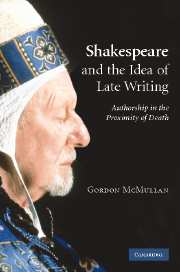Book contents
- Frontmatter
- Contents
- Acknowledgements
- Introduction
- 1 Shakespeare and the idea of late writing: authorship in the proximity of death
- 2 The Shakespearean caesura: genre, chronology, style
- 3 The invention of late Shakespeare: subjectivism and its discontents
- 4 Last words/late plays: the possibility and impossibility of late Shakespeare in early modern culture and theatre
- 5 How old is ‘late’? Late Shakespeare, old age, King Lear
- 6 The Tempest and the uses of late Shakespeare in the theatre: Gielgud, Rylance, Prospero
- Notes
- Index
2 - The Shakespearean caesura: genre, chronology, style
Published online by Cambridge University Press: 22 September 2009
- Frontmatter
- Contents
- Acknowledgements
- Introduction
- 1 Shakespeare and the idea of late writing: authorship in the proximity of death
- 2 The Shakespearean caesura: genre, chronology, style
- 3 The invention of late Shakespeare: subjectivism and its discontents
- 4 Last words/late plays: the possibility and impossibility of late Shakespeare in early modern culture and theatre
- 5 How old is ‘late’? Late Shakespeare, old age, King Lear
- 6 The Tempest and the uses of late Shakespeare in the theatre: Gielgud, Rylance, Prospero
- Notes
- Index
Summary
Suddenly in 1608 there was a change.
Late style is, I wish to argue, a concept creative artists and critics have together established in order to negotiate the proximity of death and, for this negotiation to begin in individual instances, certain conditions must be fulfilled and work done in order to establish the place of a given late style within the overarching concept. Part of that work, for the critic, involves easing readers past issues that might complicate the understanding of late style they have been encouraged to adopt as the embodiment of a certain transcendence – issues that include, as I have suggested, tone, contingency, complicity and gender. And part is the establishment in the individual case of the key criteria for the attribution of a late style. There are several such – a defensible argument that the work in question displays overwhelming evidence of genius is an obvious primary instance – but the single most basic criterion, the one from which the rest in a sense develop, is what I have called the caesura, that is, the point at which the mid- or mature-period style stops and the late style begins. Epochs, personal and social, must begin and end somewhere if they are to be distinguished and categorised, and one of the key issues in analyses of late work is the problematic idea of the divide between the late period and whatever came before it.
- Type
- Chapter
- Information
- Shakespeare and the Idea of Late WritingAuthorship in the Proximity of Death, pp. 65 - 126Publisher: Cambridge University PressPrint publication year: 2007



